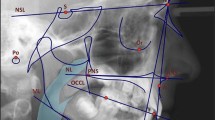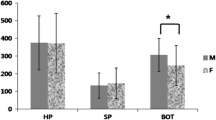Abstract
The objective of the study is to evaluate the cephalometric characteristics and investigate the measurement differences between habitual snorers and subjects with obstructive sleep apnea (OSA) in nonobese Turkish male population. The study design is prospective and nonrandomized. The setting is sleep-snoring center of referral hospital. Total of 60 male subjects constituted OSA (n = 20), habitual snorer (n = 20) and control group (n = 20). Clinical evaluation, Epworth sleepiness scale scoring, flexible nasopharyngoscopy, polysomnography, Tweed and Delaire analysis on cephalometric images were performed. The main outcome meaasures include cranial base maxillary angle (SNA), cranial base mandibular angle (SNB), posterior airway space (PAS), mandibular plane and hyoid distance (MPH), soft palate length, soft palate thickness, cranial height ratio (C2/C1), cranial base angle (C1⊥C3), and craniofacial angle (C3⊥F1) parameters were compared. In comparison of OSA and habitual snorers, PAS at palatal and tongue base level (p = 0.037, p = 0.001), MPH (p = 0.07), C3⊥F1 (p = 0.001) were found statistically different. In comparison of controls with OSA and habitual snorers PAS at palatal level (p < 0.001, p = 0.01), MPH (p < 0.001, p = 0.015), soft plate length (p < 0.001, p < 0.001) and thickness (p < 0.001, p = 0.056) were found statistically different. The soft palate length, PAS, C3⊥F1 and MPH were detected as the most effective four parameters in discriminating three groups. In conclusion, this study increased MPH, soft palate length and decreased PAS were identified as the determinant characteristics in OSA and habitual snoring group. PAS and MPH values reported were higher in OSA as compared to habitual snorers. The selected cephalometric data may be used as a complementary to endoscopic examination, sleep tests and imaging techniques to determine anatomic site, management plan and follow-up of outcome in habitual snorers and OSA subjects.


Similar content being viewed by others
References
Yu X, Fujimoto K, Urushibata K, Matsuzawa Y et al (2003) Cephalometric analysis in obese and nonobese patients with obstructive sleep apnea syndrome. Chest 124:212–218
Olszewska E, Sieskiewicz A, Rozycki J et al (2009) A comparison of cephalometric analysis using radiographs and craniofacial computed tomography in patients with obstructive sleep apnea syndrome: preliminary report. Eur Arch Otorhinolaryngol 266:535–542
Beck R, Odeh M, Oliven A et al (1995) The acoustic properties of snores. Eur Respir J 8:2120–2128
Cistulli PA (1996) Craniofacial abnormalities in obstructive sleep apnea: implications for treatment. Respirology 3:167–174
Zucconi M, Ferini-Strambi L, Palazzi S et al (1993) Craniofacial cephalometric evaluation in habitual snorers with and without obstructive sleep apnea. Otolaryngology Head Neck Surg 109(6):1007–1013
Battagel JM, L’Estrange PR (1996) The cephalometric morphology of patients with obstructive sleep apnea. Eur J Orthod 18:557–567
de Berry-Borowiecki B, Kukwa A, Blanks RH et al (1988) Cephalometric analysis for diagnosis and treatment of obstructive sleep apnea. Laryngoscope 98:226–234
Hans MG, Goldberg J (1995) Cephalometric examination in obstructive sleep apnea. Oral Maxillofac Surg Clin N Am 7:269–281
Tsai H, Ho C-Y, Lee P-L et al (2009) Sex differences in anthropometric and cephalometric characteristics in the severity of obstructive sleep apnea syndrome. Am J Orthod Dentofac Orthop 135(2):155–164
Rintala A, Nordstrom R, Partinen M et al (1991) Cephalometric analysis of the obstructive sleep apnea syndrome. Proc Finn Dent Soc 87:177–182
Djupesland G, Lyberg T, Krogstad O (1987) Cephalometric analysis and surgical treatment of patients with obstructive sleep apnea syndrome. Acta Otolaryngol (Stockh) 103:551–557
Powell NB, Guilleminault C, Riley RW (1994) Principles and practice of sleep medicine. W.B. Saunders Company, Philadelphia, pp 706–721
Maltais F, Carrier G, Cormier Y et al (1991) Cephalometric measurements in snorers, non-snorers, and patients with sleep apnea. Thorax 46:419–423
Gulleminault C, Stooks R (1991) The upper airway resistance syndrome. Sleep Res 20:250–254
Riha R, Brander P, Vennelle M et al (2005) A cephalometric comparison of patients with the sleep apnoea/hyponoea syndrome and their siblings. Sleep 28:315–320
Hierl T, Humpfner-Hierl M, Frerich B et al (1997) Obstructive sleep apnea syndrome results and conclusions of a principal component analysis. J Craniomaxillofac Surg 25:181–184
Tangugsorn V, Skatvedt O, Krogstad O et al (1995) Obstructive sleep apnoea: a cephalometric study. Part I. Cervico-craniofacial skeletal morphology. Eur J Orthod 17:45–56
Sforza E, Bacon W, Weiss T et al (2000) Upper airway collapsibility and cephalometric variables in patients with obstructive sleep apnea. Am J Respir Crit Care Med 161(2 Pt 1):335–347
Battagel JM, Johal A, Kotecha B (2000) A cephalometric comparison of subjects with snoring and obstructive sleep apnea. Eur J Orthod 22(4):353–365
Nelson S, Hans M (1997) Contribution of craniofacial risk factors in increasing apneic activity among obese and nonobese habitual snorers. Chest 111:154–162
Paoli JR, Lauwers F, Lacassagne L et al (2001) Craniofacial differences according to the body mass index of patients with obstructive sleep apnoea syndrome: cephalometric study in 85 patients. Br J Oral Maxillofac Surg 39:40–45
Johal A, Patel SI, Battagel JM (2007) The relationship between craniofacial anatomy and obstructive sleep apnea: a case controlled study. J Sleep Res 16:319–326
Johnston CD, Richardson A (1999) Cephalometric changes in adult pharyngeal morphology. Eur J Orthod 21:357–362
Delaire J, Schendel SA, Tulasne JF (1981) An architectural and structural craniofacial analysis: a new lateral cephalometric analysis. Oral Surg Oral Med Oral Pathol 52:226–238
Iked N, Hazime N, Dekeister C (2001) Comparison of the cephalometric characteristics of snoring patients and apneic patients as a function of the degree of obesity. Apropos of 162 cases. Rev Stomatol Chir Maxillofac 102(6):305–311
Conflict of interest
None.
Author information
Authors and Affiliations
Corresponding author
Rights and permissions
About this article
Cite this article
Akpinar, M.E., Çelikoyar, M.M., Altundag, A. et al. The comparison of cephalometric characteristics in nonobese obstructive sleep apnea subjects and primary snorers cephalometric measures in nonobese OSA and primary snorers. Eur Arch Otorhinolaryngol 268, 1053–1059 (2011). https://doi.org/10.1007/s00405-010-1448-z
Received:
Accepted:
Published:
Issue Date:
DOI: https://doi.org/10.1007/s00405-010-1448-z




